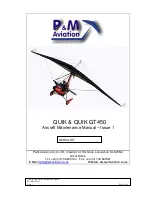
Page 13
Version 2 / PPG / 2022
In the spiral dive an uncontrolled acceleration of the canopy must be prevented. As
the canopy always accelerates via the outside of the wing, the spiral speed is
controlled via the outside brake by applying the active flying technique.
If the speed increases in an unwanted manner, pull the brakes further to slow
down. If the wing becomes too slow, it can be speeded up by releasing the outside
control.
If you pull abruptly and too far on the brakes, the canopy may enter a negative
spin. When entering a spiral dive keep the brake on the outer curve released.
The glider
does not have a tendency for stable spiral dive.
If under certain conditions, it should go into a stable spiral dive then actively exit the
maneuver by bringing your weight into a neutral position, release the brakes of the
inner curve side and brake gently on the outer curve side until you notice that the
wing starts to level out. Then gently brake on the inside curve for several turns until
normal flights returns.
Wingover
The
PICA 2
is an agile glider, and it is quite easy to get to an excessively high angle
of bank in just a few turns. Practice wingovers gently at first, as there is a chance of
quite large collapses at high bank angles.
What happens when it happens?
Knots and tangles
The best way to avoid knots and tangles is to inspect the lines before you inflate the
wing for take-off. If you notice a knot before, take off, immediately stop running and
do not take-off.
If you have taken-off with a knot you will have to correct the drift by leaning on the
opposite side of the knot and gently apply the brake line on that side too. You can
gently try to pull on the brake line to see if the knot becomes unfastened or try to
identify the line with the knot in it. Try to pull the identified line to see if the knot
releases. If the knot is too tight and you cannot remove it, carefully and safely fly to
the nearest landing place.
Be very careful when trying to remove a knot. When there are knots in the
lines or when they are tangled, do not pull too hard on the brake lines, there is
an increased risk of the wing to stalling or negative turn being initiated.
Deep / Parachute Stall
Your glider
has been carefully designed to resist entering deep stall. Before exiting
a deep stall, please ensure that the brakes are fully released. Actively exit the deep
stall by reaching up and push forward with both palms on the A-risers or pull on
them. Avoid flying in very humid air or in rain. A wet canopy may have very
unpredictable flying characteristics, one of which is a radically increased risk of
deep stall.
Never pull the brake-lines during a parachute stall, because the glider would
go into a full stall immediately. If you find yourself flying in unavoidable rain
we strongly recommend that you avoid any sudden movements or radical
Summary of Contents for PICA 2
Page 1: ...Page 1 Version 2 PPG 2022 MANUAL Version 2 PPG 2022...
Page 25: ...Page 25 Version 2 PPG 2022 Line plan all over all sizes Attention cow hitch on the CI and CII...
Page 26: ...Page 26 Version 2 PPG 2022 Line type length und title all size Under a pulling force of 50 N...
Page 27: ...Page 27 Version 2 PPG 2022...
Page 28: ...Page 28 Version 2 PPG 2022...














































